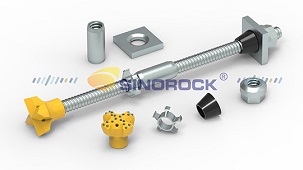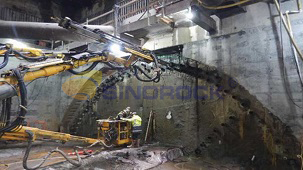How to Support Weathered Rock Formation by Self-drilling Anchor Bolts?
Time:2023-04-26From:sinorock View:
With the rapid development of society, people's demand for traffic is increasing, mountainous highways have been developed rapidly, and the scale of tunnel construction has become larger and larger. However, due to the particularity and complexity of mountainous geological structures, mountainous highway tunnels constantly increasing. In actual construction, weathered rock formations are often encountered, and problems such as drill sticking and difficulty in forming holes are prone to occur during advance support. Tunnel excavation may easily cause tunnel face collapse and cause safety hazards. The self-drilling anchor bolt is a new technology that can be drilled and grouted at the same time. It can be completed in one step without retrac the drill rod, which can perfectly solve the problem of advanced tunnel construction in weathered rock formations.Why Does Carry Out Forepiling?
During the tunnel construction process, the nature and geological conditions of the surrounding rock will change. In the tunnel under the geological conditions of loose and broken rock, the rock mass voids are developed, the structure is loose, the cementation force is insufficient, and the self-stabilization ability is poor. If the project is not handled properly, the excavation surface is prone to large collapse and roof fall, resulting in great safety hazards and economic losses. For prevent tunnel collapse, in the current surrounding rock reinforcement treatment methods, advanced small conduits or self-drilling anchor bolts, or conventional pipe sheds are routinely used. However, the traditional advanced small conduits and pipe roof support technologies require the surrounding rock to have a certain degree of self-stabilization. They cannot effectively meet the requirements of tunnel surrounding rock control under complex stratum conditions such as loose accumulations and severely weathered and broken surrounding rocks.
.jpg)
Introduction of Self-drilling Anchor Bolt
The self-drilling anchor is a support material processed from thick-walled seamless alloy steel. The system includes a hollow anchor bar, a coupler, a drill bit, a plate, a nut and a centralizer. The drill pipe and anchor bolt are combined into one, and there is a drill bit with relatively strong penetrating power in front of the rock bolt, which can easily penetrate various rocks under the drive of rock drilling equipment. The self-drilling anchor bolt can realize simultaneous drilling and grouting without the need for casing wall protection. Through pressure grouting, it can consolidate the broken rock formation and prevent the rock formation from collapsing. It is especially suitable for weathered rock, broken rock formation, backfilling Under complex geological conditions such as areas, clay and pebble layers.
Advantages of Self-drilling Anchor Bolts
l High construction efficiency
The self-drilling pipe roof can be constructed in one drilling and grouting, with fewer construction steps and high construction efficiency.
l Adaptable
The self-drilling pipe roof can be drilled and grouted at one time without pulling out the drill pipe, and it can still be constructed normally in the broken surrounding rock. It is applicable to various types of surrounding rock and has stronger adaptability.
l Low labor intensity and high safety
The self-drilling pipe roof can be constructed with a bolter rig, which is easier to mechanize. Compared with the conventional pipe roof, its labor intensity is lower. At the same time, workers can stay away from the tunnel surface during construction, which is safer.
l Low comprehensive cost
Although the material cost of the self-drilling pipe roof is slightly higher than that of the conventional pipe roof, its construction efficiency is high, it can adapt to various unpredictable surrounding rock conditions in tunnel construction, shorten the construction period, and indirectly reduce the cost of capital and equipment leasing. cost, so its overall cost is lower.

Self-drilling Bolt Construction Technology
1) Locating the line. The anchor bolts are positioned according to the designed longitudinal and transverse spacing of the anchor bolts.
2) Install the drill pipe and drill bit. When drilling, the anchor rod body is directly used as the drill rod. Section 1 The end of the drill pipe is equipped with an alloy drill bit with a grouting hole.
3) Drilling. In order to ensure the direction, slope and accuracy of the bolt, before drilling, surveyors stake out the position of the bolt, and after the stakeout is completed, adjust the angle of the rig to start drilling.
4) Stop drilling and extend the drill rod. After the first section of the anchor rod is drilled in place, use a special coupler to connect the second section of the rod to continue drilling. The free section of the anchor rod needs to be covered with a 40mm PVC corrugated pipe, and both ends of the corrugated pipe are wrapped and sealed with a film coated with anti-corrosion oil.
5) Grouting. The grouting material is pure cement grout, which should be stirred evenly and used as it is stirred, and the mixing of stones and sundries should be strictly prevented. When the grouting operation starts or stops for more than 10 minutes in the middle, it is advisable to lubricate the grout pump and pipeline with water or dilute grout. The grouting pipe is a high-pressure pipe, and the grouting pressure is ≥1.5MPa. Stop grouting when the grouting pressure is reached.

Summary
Compared with the traditional advance support construction technology, the self-drilling anchor bolts anchors reduces the construction procedures such as hole formation and hole cleaning, the advance support period is shorter, the cost is lower, and the footage is improved compared with the ordinary process and the advance pipe roof. If you have any questions on tunneling support, please feel free to contact sinorock@sinorockco.com for consultation.
latest news
-

- What Are the Applications of SDA Bolts in Hydropower Stations?
- Time:2025-08-21From:This Site
- Learn how self-drilling anchor bolts enhance slope stability, tunnel support, and dam reinforcement in complex geological conditions at hydropower stations. Optimize hydropower projects with efficient, cost-effective, and eco-friendly solutions.
- View details
-

- Slope Stabilization with SDA Bolts: Benefits & Applications
- Time:2025-08-19From:This Site
- Discover how self-drilling anchor bolts (SDA bolts) provide superior slope stabilization for highways, railways, and tunnels. Learn their key benefits, installation process, and real-world applications in loose or collapsible soils.
- View details
-

- How Self-Drilling Rock Bolts Enhance Tunnel Support in Fractured Rock?
- Time:2025-08-15From:This Site
- Discover how self-drilling rock bolts enhance tunnel support in fractured rock. Learn their benefits, installation steps, and real-world applications for safe, efficient tunneling.
- View details
-

- Sinorock 2025 Quality Month | Strengthening Quality Foundations, Empowering Product Excellence
- Time:2025-08-13From:This Site
- Sinorock’s 2025 Quality Month, themed “Strengthening Quality Foundations, Empowering Product Excellence,” successfully concluded, reinforcing our commitment to superior product quality.
- View details
-

- Sinorock Safety Month 2025 | Everyone Speaks Safety, Everyone Can Respond
- Time:2025-07-03From:This Site
- Sinorock Safety Month 2025, centered on the theme "Everyone Speaks Safety, Everyone Can Respond - Spot Workplace Hazards," has wrapped up successfully!
- View details
-

- Quality Control: the Vital Factor of A SDA Bolt Factory
- Time:2025-01-09From:This Site
- Sinorock’s comprehensive quality control system, from supplier management to outgoing inspections, ensuring the highest standards for self-drilling anchor bolts in construction.
- View details
-

- Sinorock Invites You to Explore Proven Self-Drilling Anchor Bolt Solutions at bauma 2025
- Time:2025-03-07From:This Site
- From April 7–13, 2025, explore Sinorock’s Self-drilling anchor bolt solution at Booth C2.513/4 in Hall C2 of the Messe München Exhibition Center (Munich, Germany).
- View details
-
.jpg)
- SINOROCK to Attend EXPOMINA PERÚ 2024 in Lima, Peru
- Time:2024-08-10From:This Site
- Sinorock to Attend EXPOMINA PERÚ 2024 in Lima, Peru
- View details
-
.jpg)
- SINOROCK to Participate in MINING AND METALS CENTRAL ASIA 2024
- Time:2024-08-08From:This Site
- SINOROCK to Participate in MINING AND METALS CENTRAL ASIA 2024
- View details
 Download
Download 


